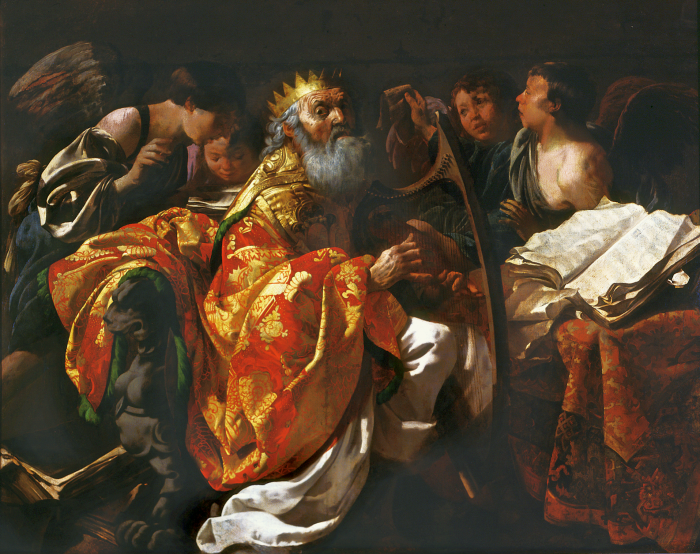
Lesson Objectives
- To see how Luke emphasizes Jesus’ lineage as Son of David in the infancy narrative.
- To see how Jesus appears in public as the Son of David throughout Luke’s Gospel.
- To understand how, at the climax of Luke’s Gospel, Jesus takes his place as heir to the kingdom of David.
III. King of the Jews
A. The New Covenant
After David had conquered Jerusalem and established himself there, God established His covenant with David (see 2 Samuel 7).
And with the Son of David established in Jerusalem as King, Luke shows us that it is time for the New Covenant (see Luke 22:20).
The words "new covenant" used in Jesus’ last supper with His disciples, recall the promises of Jeremiah (see Jeremiah 31:31-34).
The day would one day come, Jeremiah had said, when "a righteous shoot to David" (seeJeremiah 23:5) would restore the kingdom to Israel and announce a new covenant.
This is what Jesus announces at the Last Supper.
Clearly, then, the New Covenant that Jeremiah prophesied and Jesus proclaims is not a completely new departure. Instead, it is a renewal of the covenant with David, which is now transformed into something even greater.
And Luke paints the Last Supper as a royal banquet, with Jesus taking his place as King of Israel.
B. Kingdom Table
The kingdom of David had ministers and governors who sat on thrones at court.
So, too, Jesus says to His ministers and governors, the disciples: "I confer a kingdom on you" (see Luke 22:29).
The word we translate as "confer" is the same Greek word used for "covenant" in the Greek translation of the Old Testament that Luke was familiar with. In Luke’s account, the act is more than simply conferring: it is a covenant.
Just as God made a covenant with David, so God the Father makes a covenant with God the Son, and God the Son makes a covenant with His followers.
What Jesus shows us is a perfect picture of the ideal Davidic kingdom, with all the original twelve tribes that made up the Davidic kingdom are gathered together and reunited at the original capital Jerusalem.
It is a grand picture. Jesus, the King, enthroned with twelve ministers, ruling the twelve tribes of the restored Israel.
In fact, the very words of the Last Supper account remind us of the description of Jerusalem at peace in Psalm 122: the tribes all gathered together to give thanks to the Lord, and above them "the thrones of the house of David" (see Psalm 122:4-5).
C. Reading Luke
Finally, in Luke’s account of the Passion, the list of Davidic titles begins to pile up. Notice that in these final chapters of the Gospel, Jesus is repeatedly called:
·The Christ (or Anointed One) of God
· The Chosen One
·The King of the Jews
The irony, which Luke certainly means for us to see, is that these titles were all hurled as insults as Jesus was dying on the cross (see Luke 23:35-38).
There was even a sign on the cross itself: "This is the King of the Jews." It must have been very funny to the Roman soldiers in charge.
But in fact that sign, placed there in mockery, spoke the truth that Luke has been showing us throughout the book.
All those titles really did belong to Jesus, because He really was the promised Son of David: the Christ, the Chosen One, the King of the Jews.
After He rose from the dead, he appeared to many of the believers. Luke records two of those appearances in detail, and in both of them the message is the same: the prophets had already told us that the Son of David would suffer these things and be raised from the dead.
On the road to Emmaus, two of Jesus’ followers meet Him, but do not recognize Him. When they tell him the story of what happened to their Master, He explains everything that happened by interpreting Moses and the prophets (see Luke 24:13-35).
Likewise when He appears to the remaining eleven apostles, He explains that everything happened to fulfill what was written in "Moses and the prophets and the psalms" (see Luke 24:36-49)
The things that happened to the Christ (that is, the Messiah, the Anointed One) were exactly what the prophets had foretold would happen to Him.
That is what Luke’s vivid images show us over and over throughout his Gospel: Jesus perfectly fulfilled everything that was expected of the Son of David:
That sign on the cross only proclaimed what all the signs before had already made clear: "This is the King of the Jews."
Other Lessons
- Lesson One: A Throne Established Forever
- To begin to appreciate the significance of God’s covenant with David for understanding the content and meaning of the New Testament.
- To understand the biblical idea of the monarchy and the Old Testament background for the Davidic covenant.
- To understand the basic outlines of the promises made to David and the shape of the Davidic kingdom under both David and Solomon.
- Lesson Two: Looking for the ‘New David’
- To understand the basic outline of Israel’s history in the centuries between the collapse of the Davidic kingdom and the beginning of the New Testament era.
- To appreciate how the collapse and disappearance of the Davidic Kingdom shaped Israel’s hopes and beliefs in the five centuries before Christ.
- To understand how God’s covenant promises were interpreted by Israel’s prophets and how those prophecies were understood in the last centuries before Christ.
- Lesson Three: The Son of David in Matthew’s Gospel
- To understand the symbolism Matthew uses to convey the truth that Jesus Christ is the perfect Son of David.
- To see how the baptism of Jesus corresponds to the anointing of the Davidic kings.
- To understand how Matthew sees Jesus’ kingdom as the fulfillment of the promises in the prophets.
- Lesson Five: The Spread of the Kingdom in Acts
- To understand how Jesus’ parting words to His disciples form a map of the ideal Davidic kingdom.
- To see how the structure of the Acts of the Apostles follows that map.
- To see how Luke paints the nascent Church as the Davidic kingdom perfectly restored.
- Lesson Six: ‘The Key of David’: Church and Kingdom in the New Testament
- To understand the characteristics and identity of the kingdom of God as it is portrayed in the New Testament epistles and the Book of Revelation.
- To see how the Church is identified with the kingdom in the New Testament.
- To understand how the Church, as it is portrayed in the New Testament, bears the characteristics of the Davidic kingdom.

